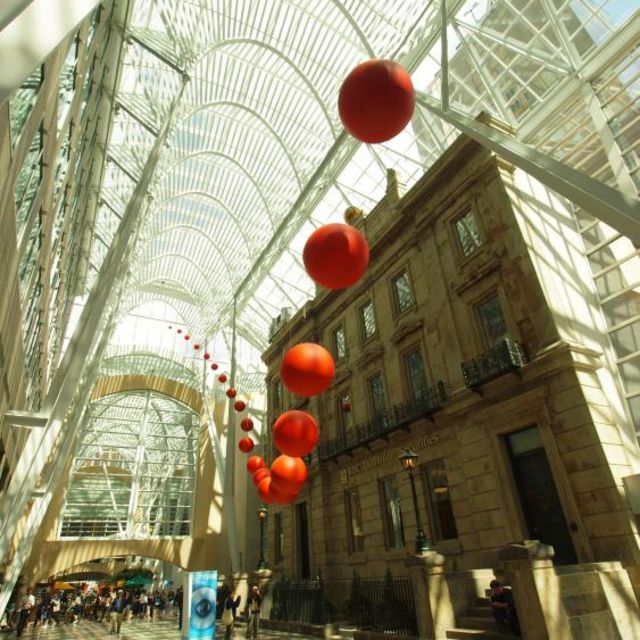Call it a juggling act Toronto architects have mastered. Since the late 1960s, their imaginative designs have struck a balance between historical preservation and the needs of developers.
As Globe and Mail architecture critic Alex Bozikovic notes, these architects were "interested in finding ways to preserve or work with the existing fabric of the city while updating it." That legacy has produced a series of landmarks where existing structure mix with exciting new additions. As architect and Architectural Conservancy of Ontario president Catherine Nasmith puts it, "Toronto people know how to do these projects." Here are six to discover.

1. Brookfield Place
When this downtown landmark—one of the first Toronto tower complexes to blend architectural eras—opened as BCE Place in 1992, the stylish interior streetscape with its soaring atrium, designed by Spanish architect Santiago Calatrava to mimic a tree canopy, was praised by critics. "The galleria will be important as a new type of privately owned public area that doesn't assume visitors are mindless consumers or office workers in a hurry to get somewhere," observed architecture critic Christopher Hume in the Toronto Star.
Continuing to deliver that promise, its natural lighting from the atrium illuminates offices, restaurants and occasional artistic installations. Lined with 19th-century buildings, the complex culminates with the former Bank of Montreal branch at the corner of Front and Yonge, which, like the Hockey Hall of Fame, now honours the legends of the ice. (181 Bay St.)
2. Royal Ontario Museum
Feel like arguing with a Torontonian? Mention Daniel Libeskind's still-controversial Crystal addition to the century-old ROM. It is one of the most talked-about examples of new-meets-old architectural fusion in the city. "It's a provocation," Bozikovic says. "Love it or hate it, every city needs that sort of building—a building that is unmissable, that makes a bold statement."
Often considered the building that kick-started the local renaissance in cultural architecture, Libeskind's addition "shows the dramatic changes that needed to happen to the ROM to bring it into the 21st century," says Michael McClelland, a principal with heritage preservation and reuse specialists ERA Architects. With the Crystal, kids can marvel at the dinosaur exhibits or hide among its angles. (100 Queen's Park)
3. Canada's National Ballet School
Walk by the windows of Canada's National Ballet School on Jarvis Street at the right moment and you might glimpse students practicing jetés and pliés. This sense of transparency is evident throughout the complex, fitting it within its surrounding streetscape.
The site skillfully blends modern training facilities contained within what Bozikovic describes as "a series of subtle, minimal glass boxes" with two 19th-century buildings: Northfield House (home of a Father of Confederation, former Ontario premier Oliver Mowat, and previously used by the Canadian Broadcasting Corporation) and Havergal College, the original home of the private girls' school. (400 Jarvis St.)
4. MaRS Discovery District
MaRS's mission of spurring innovation is evident from the way its College Street facility is built upon the pre-First World War College Wing of Toronto General Hospital. The heritage aspects are treated respectfully (the site won a Heritage Toronto Award for architectural conservation and craftsmanship in 2006), while the new additions, according to McClelland, reflect the dramatic changes happening to institutions.
Drawing on the long presence of medical institutions along nearby University Avenue, MaRS offers 1.5 million sq ft of space dedicated to aiding entrepreneurial start-ups in the fields of health, energy, work and learning. (101 College St.)
5. Maple Leaf Gardens
Sports venues rarely have second lives. Once their main tenants move on, the doomsday clock starts ticking. Maple Leaf Gardens is a rare exception, thanks to public sentiment to preserve the Carlton Street landmark. According to Bozikovic, it's a building that is "deeply important to people in the city, not just as a piece of architecture but as a place where history happened."
After a decade of dormancy, the right tenant mix emerged when the building reopened in 2012: a showcase for Loblaws's new supermarket design and athletic facilities for Ryerson University. Hockey fans will enjoy the nods to great moments in Maple Leafs history throughout Loblaws (and may be tempted to play shinny with tuna cans atop the centre-ice dot in aisle 25) and catch the Ryerson Rams in action in the arena above the store. (50-60 Carlton St.)
6. Koerner Hall, Royal Conservatory of Music
Nearly two decades in development, Koerner Hall opened in 2009, producing an intimate performance setting ideal for classical, jazz and other musical genres. Curving lines of oak create a comfortable atmosphere that places strong acoustics over luxurious trappings. The hall, part of the Telus Centre for Performance and Learning, blends into the adjoining Royal Conservatory of Music, whose Victorian-era building was the original home of McMaster University.
Nasmith feels that the discretion taken in placing the new elements beside the old creates integrity. The three levels of lobbies function as event spaces with stunning views of neighbouring landmarks like Philosopher's Walk and the Royal Ontario Museum. (273 Bloor St. W.)





